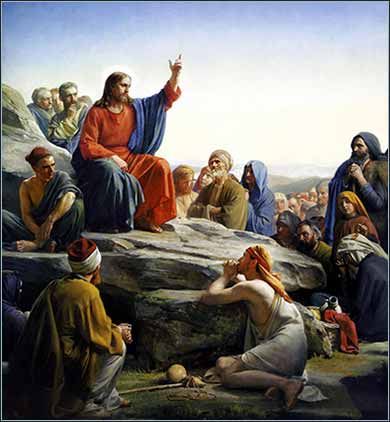Matthew 5:1-16
Lesson 7
Lesson 7
Read both the "King James Bible" and the "New Living Translation."
In this lesson:
"The Sermon on the Mount"
Jesus gave The Sermon on the Mount on a hillside near the city of Capernaum. It has been called "the constitution for the citizens of God's kingdom." Like the Ten Commandments in the Old Testament, the Sermon on the Mount is viewed as similarly important in the New Testament. This is the most studied sermon in history, yet its message continues to challenge us today. The Sermon teaches us the high standards of righteousness needed to satisfy the Jewish Mosaic Law. However, it also emphasizes that due to our sinful nature, we are unable to meet these standards. Therefore, it teaches that salvation cannot be earned by obeying the Mosaic Law alone; we need a Savior, a Messiah, to save us.
Because of its importance, the following seven lessons will be devoted to the Sermon on the Mount. As you read Matthew 5:1 through 7:29, look for two lines of teaching: God's perfect and holy standards and His merciful grace offered to sinners.
The Beatitudes (5:3-11) teach us how to live and expose the shallow faith of the Pharisees, who immersed themselves in religious legalism rather than true faith. No one can attain the degree of perfection laid out in the Sermon on the Mount (5:48), and Jesus begins the beatitudes with that in mind ("Blessed are the poor in spirit, for theirs is the kingdom of heaven"). Failing to meet the standards in The Sermon on the Mount leads Christians to recognize their spiritual shortcomings (Romans 3:20) and understand that only the grace of God and faith in Jesus Christ can ensure salvation (Galatians 3:24).
The Sermon on the Mount.
By Danish artist Carl Heinrich Bloch (1834-1890)
By Danish artist Carl Heinrich Bloch (1834-1890)
Study Tip:
It can be helpful to study from more than one translation. As you read, switch back and forth between the "King James Bible" and the "New Living Translation" below.
Also, check the margin notes in blue and click on the links.
It can be helpful to study from more than one translation. As you read, switch back and forth between the "King James Bible" and the "New Living Translation" below.
Also, check the margin notes in blue and click on the links.




